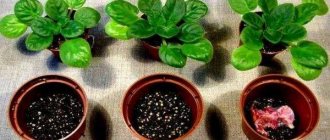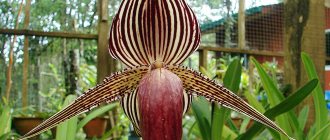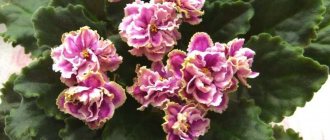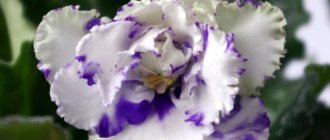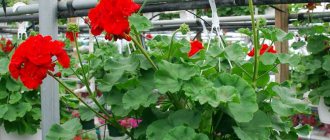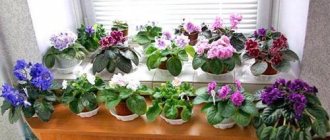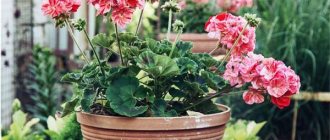A talented person is talented in everything. This statement also applies to the Russian programmer Konstantin Morev, who in his free time is engaged in breeding new varieties of violets. One of his creations is a large, large, incredibly romantic violet “Olesya”. It was bred relatively recently, the variety is not even 10 years old.
Dear readers! For you, we have created communities on social networks in which useful articles and interesting ideas are published several times a day! Subscribe and receive useful content in a convenient format!
Description of the variety
A beautiful, dense rosette, flowers of an amazing violet-pink hue, framed at the edges by a discordant, interrupted border of dark cherry color.
Pink petals smoothly flow into cream in the center of the flower. They themselves are small, there are many of them in one rosette, they bloom long and profusely.
The flowers surprise with their luxury, and at the same time they are very delicate and cute, exuding a faint aroma. They do not change their color, and the next year the flowering becomes even more luxurious and lush.
Leaves
The leaves are soft green, quilted, slightly fluffy and delicate.
They are medium in size, sink to the ground and do not cover the flowers.
During its full flowering, the rosette grows and almost completely covers the leaves, so that they can be difficult to see.
Flowers
Outwardly, it is very similar to the Dushechka variety. It differs in some nuances and shades of color - Darling has more pastel and calm tones, “Olesya” is much brighter and more cheerful.
KZ-Tsarev flower
This variety is distinguished by large, dense flowers. They are shaped like stars. The petals have a bright pink hue with lilac touches.
Violet leaves are green on the outside and red on the inside. The rosette of the plant is small and compact.
Proper care of Saintpaulia will ensure abundant and long flowering. Like other varieties, the culture does not tolerate bright sun, heat above 28℃ and excessive watering. In addition, it is necessary to remove excess leaves and shoots.
Photo of violet "Olesya" Morev
Transfer
This crop needs regular replanting. This measure is mandatory to provide flowering plants with new portions of nutrients that they will receive when replacing the soil. The essence of the process comes down to completely or partially replacing the soil in the pot every two to three months. Violets can be replanted using the transshipment method, but provided that the entire root system is healthy, light in color and free from an unpleasant putrefactive odor. In this case, there is no need to disturb the susceptible root system again. However, moss drainage must be replaced in each case.
If there are unhealthy roots, they are removed along with the soil, rooting the crop into a new, larger pot. If the plant does not have the opportunity to replace the container, and the time for the planned replanting has already arrived, you can simply replace the drainage at the bottom and remove the top layer of soil, adding a nutrient substrate on top.
Growing conditions
Violets, in principle, are grateful flowers, ready to grow in any soil. But in order for the variety to fully reveal all its qualities, the necessary conditions must be created for the flower.
Find out a detailed description of other varieties of violets: “Blue Fog”, “Cinderella’s Dream”, “Blue Dragon”, “Lituanica”, “Ice Rose”, “Esmeralda”, “Summer Twilight”, “Chanson”, “Jan Minuet”, etc. .
Correct placement
Violets are light-loving plants, but at the same time they are contraindicated in a lot of sun.
They will feel best on the east side of the apartment.
They will also bloom well on a southern windowsill - you just need to shade them well in the summer heat.
Lighting
This violet will definitely need additional lighting in short winter days, otherwise it will not form new buds and will not bloom.
Temperature
She is thermophilic, the optimal temperature for her is 22-24 degrees. For young plants - 24-26 degrees.
Humidity
For adult plants, normal room humidity is sufficient. They can be sprayed with a spray bottle 2-3 times a week. Young children are kept in greenhouses under plastic wrap.
Pot
The size of the pot primarily depends on the size of the violet itself - it must be selected in accordance with the root system of the flower itself. If you have just purchased a “baby” flower, it is very tiny, then you need the smallest pot for it.
At first, even a disposable plastic one will do. As it grows, the pots will need to be changed and replanted according to size.
For an adult flower, you need a ceramic pot, not covered with any decorations on the outside.
Its maximum height and width is 10 cm, otherwise the leaf mass will grow, but it will not bloom - the root system will grow, the plant will spend all its energy on strengthening the root, and there will be no energy left for flowering itself. In addition, in a constantly humid and warm environment, bacteria, fungi, and mold will actively begin to multiply.
If you are germinating a violet from a leaf, the leaf should be placed in a small plastic 100-gram cup in water, wait until the roots appear and transplant into exactly the same cup with soil, and wait until it takes root.
Priming
You can buy ready-made soil or make your own.
After all, if you purchased low-quality soil, this will certainly lead to the death of the flower in the very near future. What is poor quality soil? This is one that contains:
- pathological microorganisms that cause mold
- various foreign debris - twigs, leaves, etc.
- plaque of unknown origin
- acidic soil
A good, high-quality soil for violets is multi-component. It includes:
- peat - it should be fluffy, not clogged, and crumble well in your hands. This is the main component, about 2/3 of the volume is taken
- activated carbon - 2-3 crushed tablets. They will prevent soil acidification
- soil baking powder
- sorbents that absorb moisture - they will retain water, but at the same time prevent the earth from becoming waterlogged.
Properly prepared soil for flowers has a light, airy, uniform structure that is pleasant to the touch.
Important! Baking powders and sorbents often have a very strong odor that can burn your respiratory tract. Try not to inhale it too deeply, so as not to harm your health.
Keeping seedlings in indoor culture
Flower growers with great pleasure purchase seedlings of K. Morev for their collections, since these violets, which do not have varietal status, possess most of the characteristic qualities of the variety. Both seedlings are different:
- Unpretentious character;
- Easily adapt to room microclimate;
- They produce early and vigorous flowering.
To achieve this, violets need only careful and careful implementation of the most common agrotechnical measures and procedures:
- It is correct to place violets - on a western or eastern window; specimens on northern windows require additional lamps with a diffuse spectrum; on southern windows, artificial shade is required;
- Water in small volumes when the effect of slight drying of the upper volume of the substrate appears;
- Apply additional mineral fertilizers, focusing on the decorative appearance of violets;
- Lighting is created for the most part natural, long-lasting and diffused spectrum;
- Control the appropriate temperature level - within +20 + 24°C, excluding sudden fluctuations in indicators;
- Plant using nutritious, permeable soil with good aeration and a thick layer of drainage;
- When transplanting, use transshipment more often, except in special cases;
- Correct humidity indicators using any possible methods, avoiding only spraying the violets themselves.
Planting and propagation
When planting, it is important not to damage the root system of the plant.
The flower must be held above the pot so that the roots fit freely in the pot and do not touch its walls and bottom.
Gradually fill the flower with the prepared soil and moisten the soil well.
A violet of the same variety can be grown from a leaf of the plant; it just needs to be kept in water until the roots appear.
You can also propagate by cuttings - sprout roots.
Feeding
The violet variety Dushechka should be fertilized quite often. After all, it can bloom almost continuously, and therefore greatly depletes the soil. As a feed for this plant, it is worth using products that contain elements such as calcium, nitrogen, magnesium, phosphorus, potassium and sulfur. It is best to fertilize Darling with a product intended specifically for violets, which can be purchased at any specialized flower shop.
It is worth adding fertilizer to the pot more often, but after diluting it with plenty of water. In summer, these flowers are fertilized approximately once every two weeks, in winter - once a month. Actually, the nutrient solution itself must be poured under the roots extremely carefully, trying to ensure that it does not fall on the leaves of the plant.
Care
This variety is unpretentious in care.
Watering
Daily watering is not required. Water under the root to keep the soil slightly moist.
Top dressing
Fertilizers are of two types, mineral and organic. They are applied two to three times a month during watering.
Transfer
Transplanting is a more effective way to feed plants by replacing the soil in which they grow. Remove the exhausted one and plant it in a freshly prepared one. This can be done once every 2-3 months.
Reviews
Saintpaulia SM-Olesya is an unpretentious variety that is not afraid of high room temperatures . This variety grows and develops quickly and, when propagated by cuttings, produces a large number of children.
This variety blooms very luxuriantly.
How long does it take to grow an adult plant?
After the first transplant, children quickly begin to grow; with moderate complex feeding they quickly :
- Reaches the size of a starter;
- And the first flower stalks are released.
Diseases and pests
Flowers, alas, also get sick. And they also have enemies.
Diseases
These include various damage to the flower itself, stems, and leaves.
These are various rots, late blight, bacteriosis and others. Damage to the roots of the flower is no less dangerous.
A coating forms on the flower, from which it dies. You can cope with the problem with the help of special herbal remedies.
Pests
These are insects that eat the flowers or leaves themselves - aphids, mites, butterfly larvae and the like. Special chemicals that need to be sprayed on violets will help deal with them.
Peculiarities
The indoor flower, which bears the familiar name violet, belongs to the genus of beautifully flowering herbaceous plants - Saintpaulia, and has a second name used in floriculture - Uzambara violet. Today, for fans of this culture, breeders offer a wide range of species and hybrids of this plant, the main difference being the size and color of the flowers. Violet "Olesya" is quite popular among flower growers; its demand is due to its ease of care, as well as lush and rich flowering.
A special feature of the culture is a dense rosette with purple-pink buds, the attractive color of which is complemented by a border around the edge of the petals in a dark burgundy shade. The bright color of the flowers becomes more delicate towards the middle, forming a creamy core. As a rule, the flowers of this violet variety do not stand out for their large size, but flowering continues for quite a long time. During flowering, “SM-Olesya” emits an unobtrusive and very pleasant aroma.
Breeder Morev is the “parent” of this indoor variety. Thanks to his work, florists and flower growers around the world were able to cultivate such a plant on their own. According to the description of the variety, a number of characteristics can be distinguished among the distinctive features of the Olesya violet.
- This plant is notable for its dense rosette of leaves, which becomes even more expressive during the flowering phase.
- The result of the breeder's work was the development of a new variety, whose double or semi-double flowers stand out for their high decorative qualities, even if they are small in size.
- The leaf blades of the Olesya violet have a small fluff on the surface, which has a positive effect on the appearance of the entire plant.
- A culture, in the process of its growth and development, can change the shade of its flowers. At the same time, the density of flowering increases.
- "Olesya" blooms without reference to the season. As a rule, the interval between the dormant and flowering phases is about two to three months. However, when creating an optimally suitable indoor microclimate, the crop can bloom almost without interruption.


